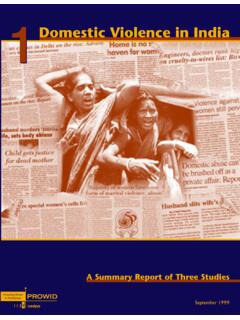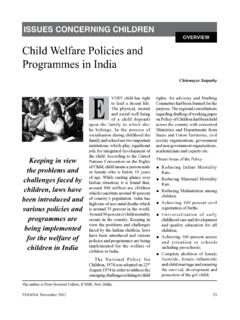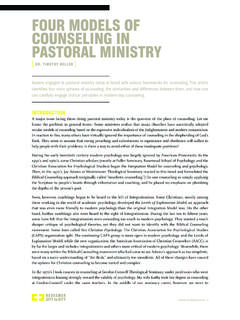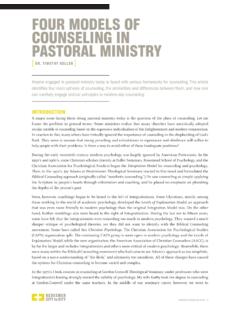Transcription of Effect of Principals’ Leadership Styles on Students ...
1 IOSR Journal Of Humanities And Social Science (IOSR-JHSS) Volume 20, Issue 3, Ver. VII (Mar. 2015), PP 51-60 e-ISSN: 2279-0837, p-ISSN: 2279-0845. DOI: 51 | Page Effect of Principals Leadership Styles on Students Academic Performance in Public Secondary Schools in Homa-Bay County, Kenya Moses Ouma Obama1; Lucy Akinyi Eunice2, and John Aluko Orodho3* 1, Is A Lecturer, Department Of Humanities And Social Sciences, Rongo University, Kenya. 2, Is A Doctorate Student, Department Of Educational Management, Policy And Curriculum Studies, School Of Education, Kenyatta University, Kenya. 3, Is An Associate Professor Specialized In Educational Research And Statistics , Department Of Educational Management, Policy And Curriculum Studies, School Of Education, Kenyatta University, Kenya Abstract: This study sought to examine the Effect of principals Leadership Styles on Students academic performances in Kenya Certificate of Secondary Education (KCSE) Examinations in public secondary schools in Homa-bay County, Kenya.
2 The study was premised on a combination of modified Bossert s framework and Pitner s moderated theoretical frameworks which contend that principal s role is influenced by intertwined factors including external antecedent variables and prevailing external environmental conditions. The study had two fold objectives, namely i) assess teachers perceptions regarding their principals Leadership Styles ii) analyze the relationship between principals Leadership Styles and Students academic performance. The study adopted an ex-post facto research design. From an accessible 39 secondary schools, 36 were randomly selected to provide 36 principals and 216 teachers yielding an overall sample size of 252 respondents. Questionnaires were piloted to determine their validity and reliability before being used to collect quantitative data from sampled subjects. The study established that principals in the study locale used Leadership Styles that were not conducive to teacher-student interactive learner-centered learning that enhanced Students academic performance.
3 A test of hypothesis using the chi-square test of association (X2 = , df =5) at =.05level of statistical significance further established that there was a significant relationship between the Leadership Styles applied by principals as perceived by teachers and Students academic performance. The schools that embraced more democratic and participatory Leadership Styles that encouraged group work and team spirit performed significantly better than those that used more autocratic Leadership Styles that were largely dictatorial. Several recommendations were made key among them being that the Ministry of Education through the Kenya Education Staff Institute (KEMI) should intensify in-service training for school principals on use of learner-centered Leadership Styles geared towards enhancing Students academic performance not only in the study locale of Homa-Bay County but other counties with similar management challenges[302 words].
4 Keywords: Principals, Leadership Styles , teachers perceptions, Students academic performance, public secondary schools, Homa-bay County, Kenya. I. Introduction Background information The current global trends towards acquisition of quality education has created heated debate on the types of Leadership Styles which school principals , teachers and Boards of Management should adopt for effective implementation of curriculum to yield high quality educational output( Ibrahim & Orodho,2014). This accelerated quest for quality education has received top priority not only in most sub-Saharan African countries but also in Kenya (Oketch & Ngware, 2012; Orodho, 2014). Quality of education measures using academic and no-academic indicators in secondary education in Kenya is neither achievable nor sustainable without the continuous assessment of these indicators on how they influence the delivery of quality education by school systems in the country.
5 Demand for educational quality is also increasing, as the Government of Kenya views the satisfactory performance of her basic education systems not only instrumentally but also strategically in relation to economic development and international competitiveness (Republic of Kenya/UNESCO, 2012). The Basic Education Act 2013 (Republic of Kenya,2013) gives the school principal through the Boards of Management responsibilities to run schools under their jurisdiction. According to section 59(a-f) of the Education Act, the functions of the principal , through the Board of Management (BoM) include: Promotion of the best interests of the institution and ensure development; promote quality education for all pupils in accordance with the standards set by the Act or any other law; Ensure and assure the provision of proper and adequate Effect of Principals Leadership Styles on Students Academic Performance in DOI: 52 | Page physical facilities for the school; determine causes of pupils indiscipline and make a report to the County Education Board; facilitate and ensure the provision of guidance and counseling to all learners.
6 Encourage the learners, teachers and no-teaching staff and others, parents and community , and other stakeholders to render voluntary services to the institution, amongst others(Republic of Kenya,2013). From the foregoing citation, the Ibrahim and Orodho (2014) made it clear that the Government of Kenya recognizes the critical role of principals through the Board of Management by prescribing very critical functions that are central to facilitating the academic development of the school and quality academic output. Thus, it is arguable that management and Leadership Styles are very important for the running of the various organizations. In line with this argument, Ball (1987) identified the following Leadership and management Styles that emerged in the course of his research in British secondary schools: the interpersonal, managerial style, adversarial and the political style or authoritarian style.
7 He describes interpersonal head teachers as being typically mobile and visible with a preference for consulting with individuals rather than holding meetings. They like to sound out ideas and gather opinions. Such head teachers will frequently reiterate to teachers the importance of bringing complaints and grievances to them first of all. Ball (1987) pointed out that this type of Leadership style is particularly effective at satisfying teacher s individual needs, and that grievances and staff turnover tends to remain low. On the other hand, he continues to argue that head teachers with managerial Styles adopt a Leadership style that parallels that of a manager in an industry: Nonetheless, it is imperative to note from the Nsubuga (2008) study that the use of management techniques involves the importation into the school structures, types of relationships and processes of organizational control from the factory.
8 The managerial head is chief executive of the school, normally surrounded by a Senior Management Team (SMT). The head teacher relates to the staff through this team and through a formal structure of meetings, Board of Management (BoM) and various school committees (Ibrahim & Orodho,2014; Nsubuga, 2008). When the BoM functions well through the Leadership of the principal , the school operations are well supervised and Students perform well in their examinations. The principal is an important personality in the governance and management of the school for several reasons which include, but are not limited to, the following: liaising with the head teachers in upholding the culture of the school, maintaining school ethics and discipline and management of school funds, management of the general welfare of the school s staff and learners, soliciting support for the school from the community and developing the quality and standards of education (Nsubuga, 2008).
9 Although some aspects of management such as instructional, administrative, democratic and bureaucratic Leadership and management Styles are always good, coercive and authoritative management Styles are always not conducive. It is against this background that this study was prompted and delved into an examination of the effects of principals management Styles on Students academic performance in public secondary schools in Homa-Bay County, Kenya. State of the Art Review Through the decades of the twentieth century, the role of school principals has greatly evolved and could generally be characterized as highly transformative (Ibrahim & Orodho, 2014). The dominant role of school principals for example in the 1930s was one of a scientific manager. In the 1940s the principal was expected to fulfill primarily the role of a democratic leader.
10 In the 1970s the principal was viewed as a humanistic facilitator, and in the 1980s school principals were expected to serve primarily as instructional leaders (Beck & Murphy, 1993). Even though instructional Leadership received great popularity and pervaded Leadership literature during the 1980s, this notion was introduced a few decades prior to this period. Mackenzie and Corey (1952) were among the early writers who referred to the school principal as an instructional leader of a school (Greenfield, 1987). De Bevoise (1984) used the term to designate the actions that school principal takes, or delegates to others, to promote growth in student learning. A number of researchers have developed theoretical frameworks of instructional Leadership roles of school principals, contributing to the clearer conceptualizations of the term.



















